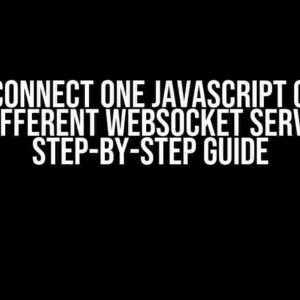Are you tired of bot traffic flooding your website, causing unnecessary stress on your server and skewing your analytics? You’re not alone! Many website owners struggle with the seemingly impossible task of blocking bot user-agents using NGINX. But fear not, dear reader, for we’re about to dive into the world of bot-blocking mastery.
What are bot user-agents, anyway?
To understand why NGINX is not blocking bot user-agents, we need to first grasp what these sneaky bots are. A bot user-agent is a type of software that mimics human behavior, sending HTTP requests to your website without any actual human interaction. Some bots are harmless, like search engine spiders, while others are malicious, engaging in scraping, spamming, or even DDoS attacks.
The problem with NGINX and bot user-agents
By default, NGINX won’t block bot user-agents, allowing them to freely roam and wreak havoc on your website. This is because NGINX relies on the `User-Agent` header sent by the client (the bot) to identify its origin. However, bots can easily spoof this header, making it seem like they’re legitimate users.
That’s where the frustration begins. You’ve configured NGINX to block certain user-agents, but those pesky bots just won’t quit. It’s like playing a game of whack-a-mole, where you block one bot, only for another to pop up.
Solution 1: Blocking bot user-agents using the `map` block
One way to block bot user-agents is by using NGINX’s `map` block. This allows you to create a custom list of known bot user-agents and block them. Here’s an example configuration:
http {
...
map $http_user_agent $blocked {
~*bot 1;
~*crawler 1;
~*spider 1;
default 0;
}
server {
listen 80;
server_name example.com;
if ($blocked) {
return 403;
}
...
}
}
In this example, we’re creating a `map` block that checks the `User-Agent` header against a list of known bot patterns. If the header matches any of these patterns, the `$blocked` variable is set to 1. Then, in the `server` block, we use an `if` statement to return a 403 Forbidden response if the user-agent is blocked.
Limitations of the `map` block approach
While the `map` block method is effective, it has its limitations. Maintaining a list of known bot user-agents can be a tedious task, especially considering the ever-evolving landscape of bot development. New bots with custom user-agents can easily bypass this block.
Solution 2: Blocking bot user-agents using the `http_user_agent` directive
A more robust approach is to use the `http_user_agent` directive, which allows you to block user-agents based on specific patterns. Here’s an example configuration:
http {
...
server {
listen 80;
server_name example.com;
http_user_agent ~*bot|crawler|spider {
deny all;
}
...
}
}
In this example, we’re using the `http_user_agent` directive to block any user-agents containing the words “bot”, “crawler”, or “spider”. The `deny all` statement ensures that these user-agents are blocked from accessing the website.
Combining multiple blocking methods
For maximum protection, you can combine multiple blocking methods. Here’s an updated configuration:
http {
...
map $http_user_agent $blocked {
~*bot 1;
~*crawler 1;
~*spider 1;
default 0;
}
server {
listen 80;
server_name example.com;
if ($blocked) {
return 403;
}
http_user_agent ~*bot|crawler|spider {
deny all;
}
...
}
}
By combining the `map` block and `http_user_agent` directive methods, you’ll have a more comprehensive bot-blocking system in place.
Additional Security Measures
While blocking bot user-agents is an essential step in securing your website, it’s not the only measure you should take. Here are some additional security tips to consider:
- Rate Limiting: Use NGINX’s built-in rate limiting feature to restrict the number of requests from a single IP address within a specified time frame.
- IP Blocking: Block IP addresses known to be associated with bot activity using NGINX’s `deny` directive.
- Header Validation: Validate HTTP headers to ensure they’re legitimate and not spoofed by bots.
- Regularly Update NGINX:** Keep your NGINX installation up-to-date to ensure you have the latest security patches and features.
Conclusion
NGINX is not blocking bot user-agents by default, but with the right configuration and security measures, you can effectively block these malicious actors from accessing your website. By combining the `map` block and `http_user_agent` directive methods, you’ll be well-equipped to handle the ever-evolving bot landscape.
Remember, security is an ongoing process, and it’s essential to stay vigilant and adapt to new threats as they emerge. By following the tips and techniques outlined in this article, you’ll be better prepared to protect your website from bot user-agents and other malicious actors.
| Keyword | Description |
|---|---|
| NGINX | Open-source web server software |
| Bot user-agents | Software that mimics human behavior, sending HTTP requests to a website |
| Map block | NGINX directive used to create a custom list of known bot user-agents |
| Http_user_agent | NGINX directive used to block user-agents based on specific patterns |
FAQs
- Q: What is the difference between a bot and a web scraper?
A: A bot is a general term for software that mimics human behavior, while a web scraper is a specific type of bot designed to extract data from websites. - Q: Can I block bot user-agents using .htaccess files?
A: No, .htaccess files are specific to Apache web servers, and NGINX uses a different configuration syntax. - Q: How often should I update my bot-blocking configuration?
A: You should regularly update your bot-blocking configuration to stay ahead of new bot developments and patterns.
Frequently Asked Question
Let’s dive into some of the most common questions about NGINX not blocking bot user-agents. Because, let’s face it, those pesky bots can be a real nuisance!
Why isn’t NGINX blocking those unwanted bot user-agents?
Well, it’s likely because your NGINX configuration isn’t set up to block them. You need to specify the bot user-agents in your `conf` file and configure the server to deny or rate-limit them. Don’t worry, it’s an easy fix!
How do I identify bot user-agents in the first place?
You can use tools like `curl` or `wget` to inspect the User-Agent headers of incoming requests. Alternatively, you can use a third-party service like User-Agent String Analyzer to help identify those sneaky bots. Once you have the list, you can configure NGINX to block them.
What if I don’t have a comprehensive list of bot user-agents?
Don’t worry! There are many online resources that provide lists of known bot user-agents. You can also use a third-party service like Cloudflare or Akamai to help identify and block malicious traffic.
Will blocking bot user-agents affect legitimate traffic to my website?
Nope! When configured correctly, NGINX will only block traffic from the specified bot user-agents, leaving legitimate traffic untouched. Just make sure to regularly update your list of blocked user-agents to avoid false positives.
How often should I update my NGINX configuration to block new bot user-agents?
It’s a good idea to regularly review and update your NGINX configuration to stay ahead of those pesky bots. You can set up a schedule to review and update your configuration every few months or whenever you notice an increase in unwanted traffic.





